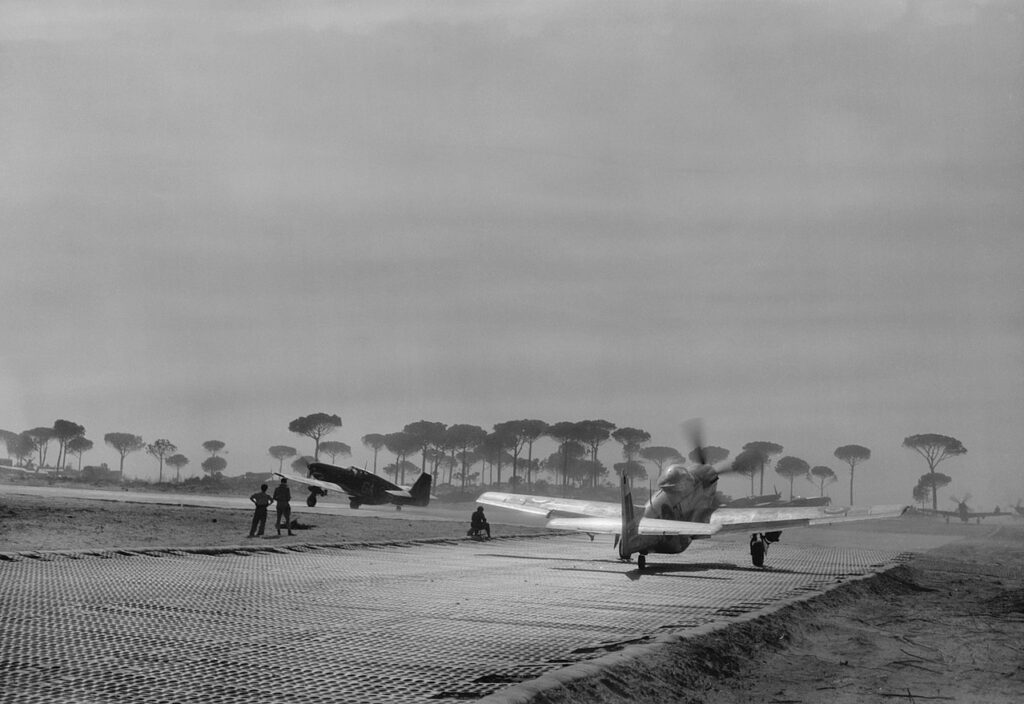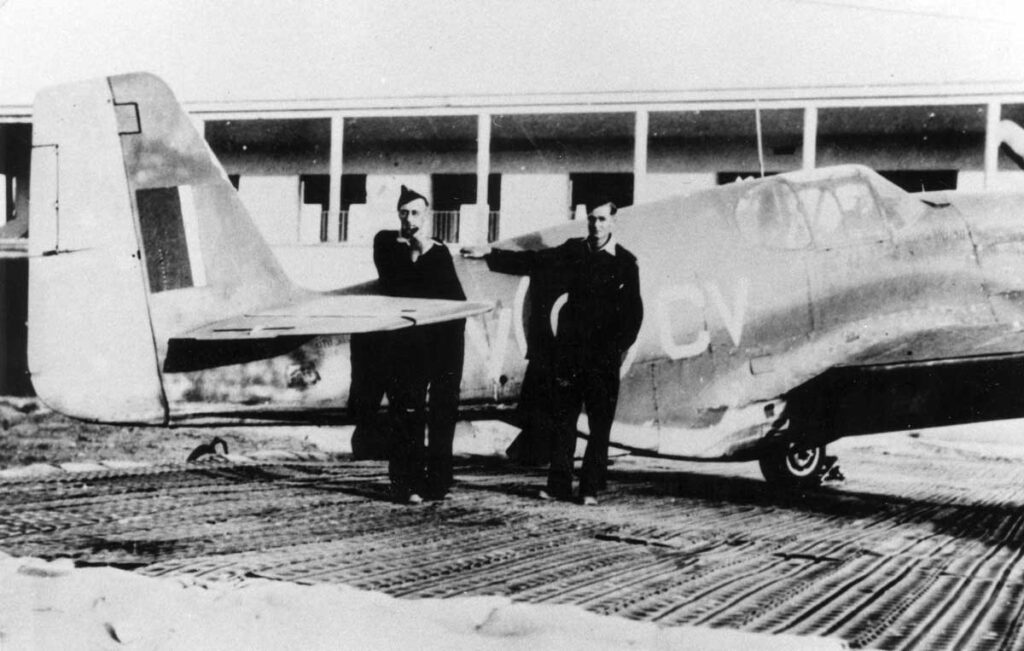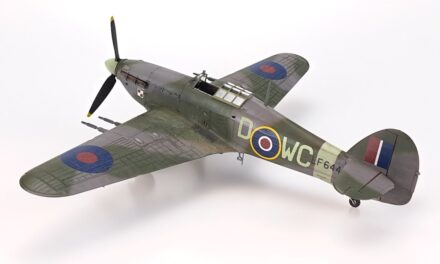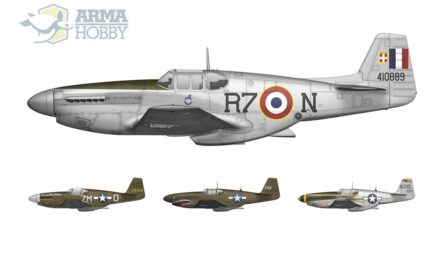The best-known “shark’s jaws” (or “shark mouth”) from No. 112 Squadron RAF were those painted on the different versions of its Curtiss P-40 fighters. Indeed, they gave the unit its name: “Shark Squadron”. However, in the spring of 1944, while fighting on the Italian Front, the squadron transferred to the Mustang Mk III…
112. Squadron RAF, „Shark Squadron”
The history of No. 112 Squadron RAF goes back to the First World War. It had been established in Great Britain in 1917 for the purpose of defending London against aerial attacks launched by German Gotha and Zeppelin-Staaken heavy bombers. In 1918, the pilots were sent to France. The unit was disbanded in 1919 during the nationwide demobilization. Twenty years later, however, on 16 May 1939, the squadron was recreated and returned to service. But the circumstances were unique, for the unit’s “rebirth” took place on the aircraft carrier HMS Argus, which had set sail from Southampton to Egypt. The airmen were actually provided with aircraft – Gloster Gladiator fighters – only some time after their arrival in Alexandria. In 1940, having been tasked with the defence of Egypt and Sudan, they went into battle against the Italian Air Force. In January 1941, while still operating the Gladiators, the unit was sent to Greece, where it fought until the country’s collapse. In July 1941, after returning to Egypt via Crete, the squadron received American Curtiss P-40 fighters. It flew these aeroplanes for quite a few years, among others in support of the land army of the British Empire in North Africa, on Sicily and in Italy. The final version of the P-40 operated by the unit was the Kittyhawk Mk.IV (P-40N). However, these aircraft were not used for long; having been introduced in April 1944, they were phased out by June of the same year and replaced with the North American Mustang Mk.III.
[A very interesting selection of photos from 112. Squadron in Italy you can find here: link]
Two generations of Mustang fighters from 112. Squadron, Mustang III and Mustang IV taxing in Cervia, Italy. Photo: Wikimedia Commons
“How does a Mustang with shark’s jaws look like?”
It was in Italy, on 15 February 1944, that the first Mustang was delivered to No. 112 Squadron RAF in order for pilots and ground crews to familiarize themselves with the new fighter. According to an entry in the Operations Record Book (ORB), one of the first questions was “How will a Mustang with shark’s jaws look like?”. But those who inquired had to wait until 21 June, when Capt. McLean together with five other pilots flew to Blida (in Algeria) to collect the squadron’s first batch of Mustangs. On 22 June, the unit flew its last combat mission on Kittyhawks. Further entries in the ORB appear to suggest that the squadron’s ground crews quickly tamed the Mustangs, and already on 23 June the commander of No. 112 Squadron RAF made the first flight on a Mustang with shark’s jaws. On 24 June, the unit transferred to Faleria airfield, where the pilots underwent training on the new fighters. The process was completed on 4 July. A day later, the squadron flew four combat missions on Mustangs.
Although the British are unwilling to admit the fact, the shark’s jaws painted on the radiators of No. 112 Squadron’s Curtiss’ was probably inspired by the nose art of a German Messerschmitt Bf 110 from ZG26, whose wreck the pilots had seen during earlier fighting.
„Sharks” from 112. Squadron. Curtiss P-40/Kittyhawk III fighters. Medenine, Tunisia, 1943. Photo: Wikimedia Commons
– The jaws certainly drew our attention. – recounts Clive Caldwell, who later commanded the squadron. – But in spite of the widely held view it had many variations. The quality of presentation depended mainly on whether we had time. During periods of intense combat operations, high losses and frequent changes of airfields, ensuring superior quality paint schemes was the least of our priorities. […] Initially, the image of the mouth underwent considerable development. But while it is true that it was applied to nearly all the P-40s of No. 112 Squadron RAF, it decorated the Tomahawks of my previous unit, No. 250 Squadron RAF, or indeed those of No. 3 Squadron RAAF, in equal measure. The only difference was that the media for some reason chose us, the 112.Sqn, and noone else, to be the true carriers of the shark jaws. I cannot say that the squadron was opposed to this distinction.
[From: A. Zbiegniewski. 112 Sqn „Shark Squadron”. 1939-1941. Lublin 2003]
Mustang III GA-S/FB328
Unfortunately, documents which I have researched contain no information as to when exactly Mustang III no. GA-S/FB328 was delivered to the squadron, however we do know that it took part in a mission on the first day of Mustang combat operations. On 5 July 1944 at 18.10, Sgt. W. D. Muster together with five of his colleagues departed on a mission to attack enemy positions. According to the ORB, all of the aircraft carried bombs, which were dropped within a radius of approximately 50 m from the target. The next entry in the ORB concerning Mustang GA-S was made only on 14 July 1944, when six fighters were sent to bomb targets in “K” sector (a letter on a grid map used by the British forces in Italy; I think we can safely conclude that it represented an area located in the vicinity of Arrezo). More ground support missions were flown over the next few days, targeting German artillery and infantry placements. Since the majority of the operations in which our protagonist participated were in support of land forces and focused on attacking rear-echelon enemy ground targets, I have decided to present only a few of the most effective assaults.
Photo: Richard Sullivan. Creative Commons License Attribution-Share Alike 4.0 International
On 18 July, Mustang GA-S was flown by a South African pilot, 2nd Lt. W. J. Illidge, on a mission to bomb river and ocean going barges in Rimini. A total of 12 Mustangs took part in the operation. The pilots reported four direct hits on enemy vessels, while one bomb fell on the quayside at which they were standing. On 28 July, a group of twelve Mustangs were sent to attack an enemy encampment, however the low-lying clouds forced the mission to be aborted and the aircraft returned to base together with their bomb loads. Mustang FB328 was piloted by F/Lt P. W. Lowell. Another participant of the failed assault was Mustang III no. FB244, which featured on the first box of Arma Hobby’s model of Mustang III no. FB244. Interestingly, while flying with No. 112 Squadron RAF it also carried the individual letter “V”.
On 26 July, No. 112 Squadron RAF sent twelve Mustangs to attack a bridge and a railway crossing in the vicinity of Imola. Mustang GA-S was flown by 2/Lt D. A. H Clark (SAAF). The ORB entry informs that the target received a direct hit.
A day later, on 27 July, the unit was granted a rare honour, as it was visited by King George VI.
Shortly after 06:00 on 6 September, No. 112 Squadron RAF set off on a tactical reconnaissance in the direction of Udine. Mustang GA-S was flown by P/O Edward Trees. The mission turned out a great success, with the airmen encountering a great many targets. To start off, they attacked ships in the Bay of Trieste. Once they had dropped their bombs, the commander sent two aircraft back to base to report on intense shipping movements, and led the rest northwards. Near Grado, the pilots noticed a few field airstrips. There were aircraft on one, and the Mustangs duly strafed them with their half-inch machine guns. Next, the fighters shifted their attention to trains. After returning to base, the pilots reported that they had destroyed or damaged five locomotives, seven rail-coaches, nine aeroplanes and one small tanker.
More triumphs followed a month and a half later, on 9 September, when the squadron carried out a total of five combat missions. Mustang GA-S took part in three. In the first and fourth, which were the most successful, Mustang GA-S was once again piloted by P/O Trees, while during the second it was flown by Sgt. W. E. Moyld.
The first attack took place over north-eastern Italy (the Grado – Trieste region), and focused on both sea and land targets (including the airfield near Grado). Following their return to base, the pilots reported destroying twelve steam locomotives, one ship, one He 111 bomber and two tanker lorries, damaging one rail-coach, two Reggiane RE 2001 aircraft, two Messerschmitt 109s and four SM.79 bombers, and also strafing numerous other ground targets and ships.
During the fourth mission, equally fruitful, six pilots from No. 112 Squadron destroyed three SM.79 aircraft and one Ju 52 (on the ground), one locomotive and one rail-coach, while at the same time damaging three SM.79 bombers, one unidentified aeroplane and one locomotive. F/Lt R. V. Hearn, the mission commander, shot down one Junkers 88.
On the evening of 10 September, eleven Mustangs set off to attack railway targets in Padua and Vicenza, where they knocked out six locomotives and ten trucks, and damaged a further seven locomotives and ten trucks.
On 22 September at 09:30, a group of twelve Mustangs embarked on a combat patrol over northern Italy, starting from Canale di Leme (Lim bay in present-day Croatia) and flying over Pordenone, Treviso and Padua. The aircraft attacked both ground targets and surface vessels. The pilots reported knocking out seven locomotives and damaging one ship, one diesel locomotive, and one aeroplane at Villa airfield. During the attack on shipping, anti-aircraft artillery shot off the cockpit canopy of one of the fighters, and the pilot turned back to base escorted by another Mustang. According to the ORB, the two aircraft that were the first to return were GA-S and GA-X. However no mention was made of which had suffered damage.
Deteriorating weather in October and November 1944 limited the number of combat flights. In October, the unit regularly took part in so-called cab rank missions (which consisted in maintaining an airborne reserve of fighter-bomber aircraft that could be called in at short notice to provide close air support).
On 1 November, No. 112 Squadron RAF set off on a combat patrol over Yugoslavia, between Sarajevo and the township of Brod. Mustang GA-S was piloted by P/O E. Trees, who had flown it on numerous other missions. After returning to base, the pilots reported destroying six locomotives and damaging one.
Mustang III GA-S/FB328 was mentioned in the unit’s ORB for the last time on 6 November 1944. P/O Trees took the aircraft on its final combat mission – a patrol over Yugoslavia, between Zagreb (present-day Croatia) and Maribor (present-day Slovenia). The aircraft attacked railway targets and destroyed three locomotives.
Interestingly, P/O Trees finished his period of service with the squadron on the same day; according to information taken from a website devoted to No. 112 Squadron RAF, he was transferred to a different unit. Unfortunately, the ORB does not provide any specific information.
Paint Scheme and Technical Details
Mustang III no. FB238 was manufactured as P-51C-1-NT (it came from the same production batch as no. FB244 GA-V/CV-V). It entered service with the Royal Air Force in March 1944.
According to information gathered while working on the article about Mustang CV-V/FB244, both aircraft were factory-painted with American paints: ANA 613 Olive Drab and ANA 603 Sea Gray on the upper surfaces, and ANA 602 Light Gray on the undersides. Obviously, we cannot exclude the possibility that the aeroplane was at some point repainted in Dark Green, Ocean Grey and Medium Sea Grey, however if this had indeed been the case, it probably occurred at a later date. Although a Sky-coloured stripe was affixed to the rear of the fuselage, the photograph clearly shows that it had been painted over – as was standard practice on the Italian Front. The only fragment left uncovered was that with the serial number. It would also appear that the aircraft had yellow quick identification markings on the wing leading edges, between the machine guns and the wing edges.
Australian Mustang FB244/CV-V, Spring 1945. Aeroplane was used in 112. Squadron as GA-V (See Kangaroos on Mustangs link)
As far as I have managed to determine, the aircraft did not have an additional fuel tank in the fuselage, as these were factory-fitted only on later production Mustangs. Needless to say, many of the fighters which left the factory without such tanks were retrofitted later on. However, the workshop modification required some 450 man-hours, and RAF commanders decided that this was essentially pointless for regular combat aircraft.
The fighter did not have a tail fin and was from the B/C series of Mustangs, which were fitted with an additional hot air intake for the carburettor behind the exhaust pipes. It was also equipped with a Warren McArthur seat and a Sutton harness.
English transaltion by Maciek Zakrzewski
See also:
- Buy P-51 B/C Mustang™ Model Kits in Arma Hobby link
Wszystko co chcecie wiedzieć o Mustangu z Arma Hobby i nie boicie się pytać
An enthusiast of air war during the Battle of Britain, over North Africa and Italy, over South East Asia and France in 1940. In free time builds models in 1/72 scale, and from time to time in 1/48 scale.
This post is also available in:
 polski
polski












